When you’re on a mission to build a six-pack ab and get a well-toned firm core, waking up every day to bloated abdominal muscles can be the most frustrating thing ever.
Identifying bulging abdominal muscles can be a bit tricky at first glance, especially since it’s easy to blame your belly pooch for bloating after eating a large meal.
However, there are key distinguishing factors between both conditions, as both belly bloat and bulging abs are caused by very different things.
Contents
Tips And Tricks To Fix Bloated Abs | Five Workouts For Abs
For starters, belly bloat tends to be more of a gastrointestinal issue caused by a buildup of gas in the abdomen, according to Harvard Medical School. This, in turn, gives your abs a puffy or distended appearance.
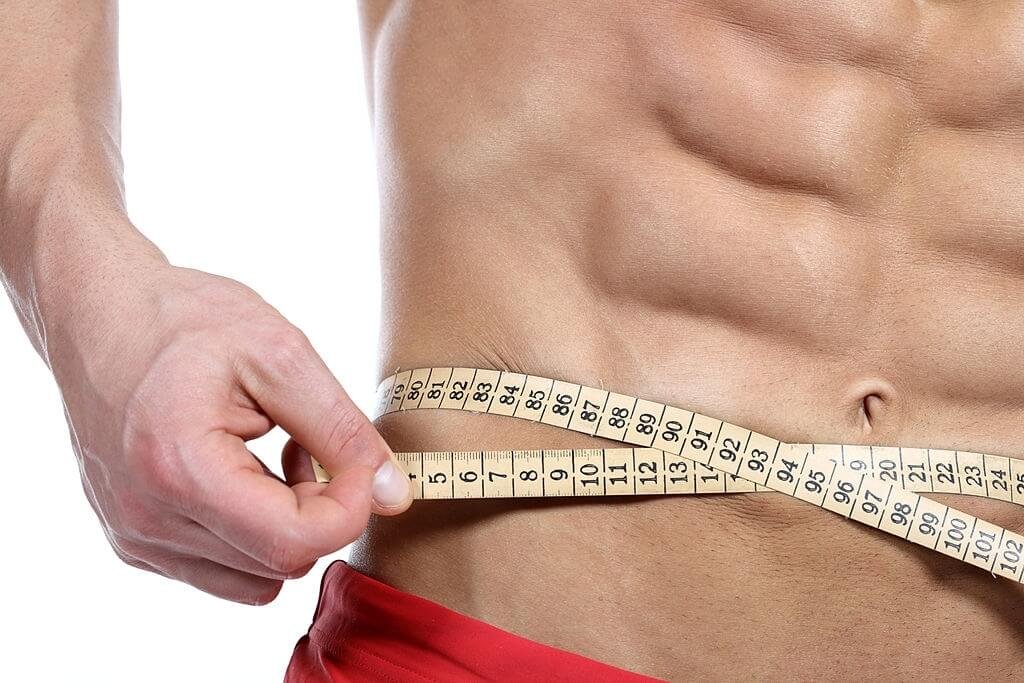
Belly bloat can also be triggered by food and sensory responses, and by underlying gastrointestinal conditions such as irritable bowel syndrome and celiac disease.
However, you can fix and prevent bloated abs by making certain lifestyle changes and incorporating specific core exercises into your regular workout routine. Here’s exactly how to diminish bloating and get the six-pack abs you want with the simple combo of ab exercises and lifestyle changes!
What Causes Bloated Abs?
Before jumping into ways that you can fix your bloated abs, you first need to identify exactly what’s causing them. These include:
- Poor lifting practices
It’s true that exercise can cause the abdominal muscles to bulge. Geoff Tripp, head of fitness science at Trainiac, suggests that lifting heavy loads, with poor abdominal bracing, can cause this condition.
“Oftentimes, it’s not a single exercise that creates this, but rather a period of time where poor lifting practices lead to the development of the diastasis recti,” Tripp said. “Excessive weight gain also stretches the abdominal muscles and the linea alba.”
- Tears in the abdominal muscles during pregnancy
Tears in the diastasis rectus abdominal muscles can occur during pregnancy, as the abdomen expands to support the growing baby, Marko says. And while women typically don’t feel these tears (they happen slowly as the baby grows), Marko explains that you may feel pressure in the abdominal area and that your belly is stretching out too much.
To avoid any unwanted discomfort, Marko recommends investing in a pregnancy belt to help hold you in throughout your pregnancy.
- Incorrect breathing techniques
When the abdomen is bloated, however, it can press against the diaphragm, thereby inhibiting its movement. This can make breathing difficult. In other cases, conditions that affect lung capacity and breathing can cause swelling or bloat in the abdomen.
- Gastrointestinal issues
These conditions are entirely different yet they both cause bloated abs. You first must identify which condition you have before diving into how to get rid of the bloated abs.
To start, most gastrointestinal issues are caused by a buildup of gas in your stomach. That buildup of gas could be caused by several things including:
- Overeating large meals
- Lactose intolerance
- Excessive water retention
- Constipation
- Gluten intolerance
Everyone at one point or another in their life has probably experienced bloated abs from gastrointestinal issues. Thankfully, because it is very common, it can most likely be fixed with some simple dietary changes.
- Weight Gain
Weight gain in the midsection can put tension on the waistline area and cause swelling in the abs. Having excess body fat, particularly belly fat, is also associated with poor posture which can further aggravate the already bulging abs.
Are Bloated Abs Permeneted?
Nothing in this world is permanent and therefore, bloated abs are no exception. Bloating and lower abdominal pain due to digestion issues or menstruation will typically resolve with time.
You can do some things at home that may help relieve bloating and lower abdominal pain due to certain causes: Exercising can release air and gas that’s built up in the stomach.
There are a number of ways to get rid of bloating. Proper diet, healthy nutrition, and a diverse and fit lifestyle will help you get rid of the bloated abs in no time.
How To Flatten My Bloated Stomach?
There are various common tips and tricks to flatten a bloated belly. Here’s a few ways curated specially for you all to get the core burning!

- Breathing
Although breathing is involuntarily fundamental to living, breathing properly during exercise is essential for growth and development. When we’re working out, our muscles require a greater amount of oxygen to function effectively.
By breathing incorrectly, or holding your breath at the wrong times, you’re depleting your muscles and brain of oxygen, and upping your risk for potential injuries.
To avoid any potential abdominal injuries while working out, breathe out as you exert yourself, especially when you’re lifting something heavy.
Having a wide stance with your legs also helps ensure that your spine is neutral, as you don’t want your back to be arched. Otherwise, you’ll have a difficult time stabilizing your pelvis and spine, as your abdominals will expand and stretch out.
- Stretching
Stretching is another key component in abdominal growth and development. Stretching lengthens muscle tissue and increases flexibility, allowing for both increased performance, and creating a greater range of motion and recovery.
- Hydration
Even staying hydrated is another key component to flattening your abs for several reasons. Staying hydrated increases metabolism decreases appetite, and in turn, helps lose stomach fat.
To stay hydrated throughout your workouts, a good hydration rule to remember is to consume half of your body weight in fluid ounces per day. When exercising, increase that amount by 12 to 24 ounces per hour depending on demands.
A more demanding longer workout in the heat will require more fluid, as well as the replacement of electrolytes, so muscle contraction can take place. A drop of 1 to 3 percent hydration will drastically affect your performance, so it is important to stay hydrated throughout the day and during exercise, with moderate fluid replenishment.
- Nutrition
While exercise is crucial in maintaining adequate physical health, there are times when situps and ab crunches aren’t enough.
Working out, and not making appropriate dietary changes, for example, can spell trouble for your waistline, she explains, as it allows the muscle to be created on an already large abdominal area.
If someone just did crunches and didn’t do anything to lose weight, they can appear to increase their belly size and increase their pooch. To decrease the size of your abdomen, one would need to lose weight, as it works to reduce belly size in inches.
Focus on eating a balanced diet to fuel your exercise routine and avoid foods that cause gas, such as vegetables in the cabbage family, dried beans, and lentils.
Five Workouts For Abs
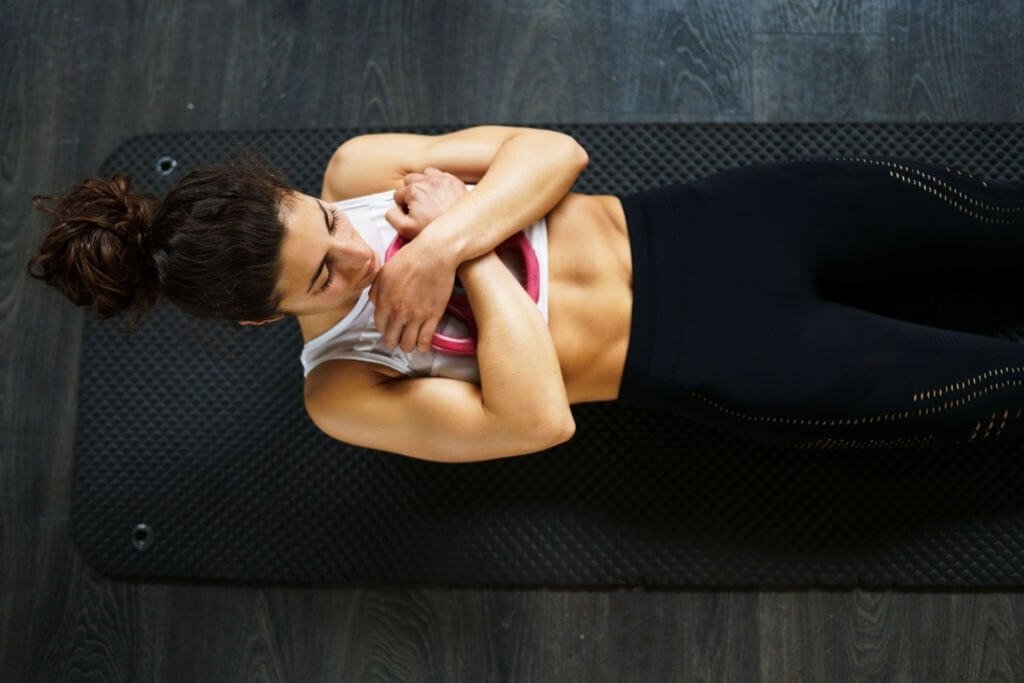
In order to flatten bulging abdominal abs safely, pelvic floor exercises, isometric exercise, and abdominal wall bracing drills are worth trying.
These exercises engage the abdominal muscles and help strengthen and stabilize your core, he adds. A stable core is a strong core, just like a stable leg is able to handle more load. Without a stable core, it is harder to build strength across all of your lifts.
- Pelvic floor exercises, such as Kegels

Kegel exercises are a good pelvic floor exercise to add to your daily workout routine, Tripp says, as they can be done sitting (on a chair or exercise ball), lying down, or standing up.
To perform this exercise correctly, remember to engage and hold your deep pelvic floor muscles. Since your deep pelvic floor muscles need practice, Tripp suggests that high reps are usually required for Kegel exercises.
Instructions:
- Identify the pelvic floor muscles — the easiest way to do this is to stop peeing midstream.
- Contract your pelvic floor muscles and hold for 1 to 2 seconds.
- Do 10 to 20 reps each session, and repeat 2 to 3 times per day.
- Isometric exercises, such as planks
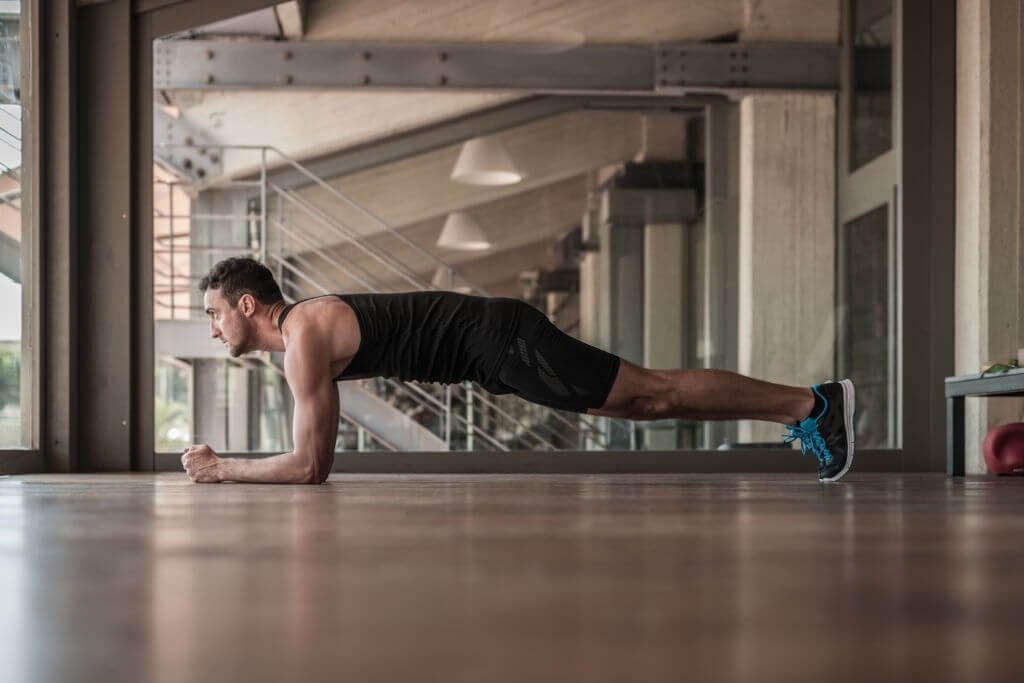
Planks are a great example of isometric exercises, as they’re an easy way to help bring your abs together.
- Traditional planks: Traditional planks are the go-to isometric hold exercise for the abdominal muscles. Get into position by starting on all fours and balancing on your hands and toes. Your hands should be planted on the floor right underneath your shoulders.
The most important thing is that you create one long line with your body. From your neck to your heels, your back should be completely neutral. Once in position, squeeze your entire abdominal region and hold the position.
If your wrists hurt from doing the exercise on your hands, you can do a forearm plank instead. To get a better idea of exactly how long you should hold your plank for, check out our complete guide to planks.
- Side planks: Start by getting into a traditional plank position on your hands and toes. Once you’re balanced, lift your right arm off the ground and reach it to the sky so that your body begins to rotate. Turn your core and feet open towards the right so that your left hip faces the ground.
Place your right hand on your hip and hold the position. As you hold the position, make sure that your left hip stays lifted high and doesn’t sink towards the floor. The way to do that is by squeezing your obliques.
After holding on to the right side, switch and open up to the left side. Unlike traditional ab exercises that work the front of your stomach, side planks work the oblique muscles. The obliques are also known as your side abs and are essential to work if you want to achieve a fully flat belly look.
- Side planks with a trunk twist: To round out your abs workout, upgrade your side planks to side planks with a twist. This little extra twisting movement goes a long way to fire up your obliques.
From your right-side side plank, take your right arm and reach it underneath your left hip so that your trunk twists downward. Then, lift the right arm back up towards the ceiling.
Keep twisting your trunk opened and closed. Do ten twists with the right arm and then switch sides and do 10 with the left arm.
- Abdominal wall bracing exercises such as dead bugs
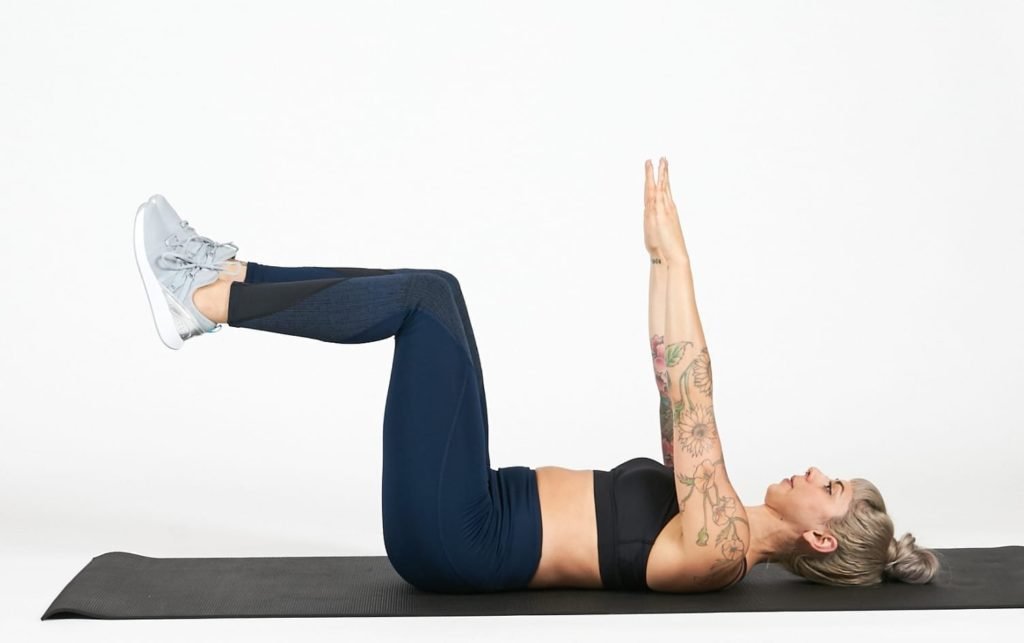
Abdominal wall bracing drills, such as the dead bug, are another good exercise. They’re isometric in nature, but you can add small movements to challenge your core strength and stability.
The nice thing about these drills is that they also transfer into your lifts, so you know heading into a heavy lift how to properly brace your core.
Instructions
- Start by lying flat on your back, pulling your knees to your chest, bending your knees to 90 degrees, and reaching your hands into the air.
- Next, begin to engage your core by pulling your rib cage down and pelvis up. This will push your back into the ground. Do your best not to arch your back off of the ground.
- Then, in a controlled manner, reach one arm down toward the ground, reaching up above your head, as you lower the opposite leg. Always be sure to alternate sides one at a time, as this helps maintain core stability.
- Aim to perform 2 sets of 6 to 10 repetitions, 1 to 3 times per day.
- Pilates pelvic floor workout
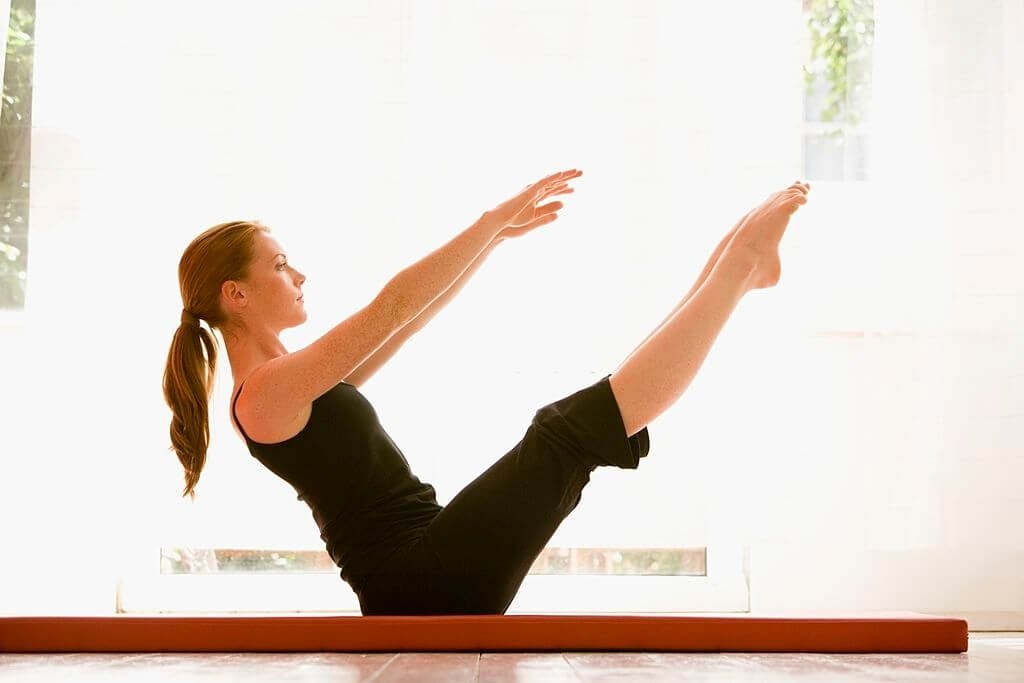
Pilates is an often-underestimated workout. Most of the exercises look easy, but they unexpectedly burn. Pilates is also great for strengthening the hard-to-reach pelvic floor muscles.
The pelvic floor is the base of your entire abdominal region. When the pelvic floor is strong, your entire ab region becomes stronger and more stable. And, when your abs are strong and stable, you’re less likely to run into over-use-related injuries.
- Glute bridges: Lay flat on your back in a neutral position with your arms by your sides and feet pulled in towards your glutes.
Exhale and press down into your heels so that your hips lift off the ground. Lift them as high as they will go while still keeping your feet planted on the floor.
Imagine as if your hips are attached to a string and suspended in the air. Squeeze your glutes at the top, and then slowly lower your hips back down to the floor. Do ten repetitions of lifting and lowering your hips.
- Bird dog: Not only do bird dogs work your pelvic floor muscles, but they also challenge your shoulders and upper back. They are a great addition to any home workout. Start on your hands and knees with a neutral back.
Your hands should be directly under your shoulders and knees under your hips. Then, lift and straighten both your right arm and left leg until they are parallel with the floor.
Squeeze your muscles, then slowly drop both limbs back to the floor. Repeat on the other side with your left arm and right leg. Continue to alternate between the two sides.
- Clamshells: Lay on the right side of your body in a completely straight line. Then, prop your head in your hand and bend your knees so that your knees move forward and your feet align with your glutes. Your left leg should be resting on top of your right leg.
Keeping your feet together, open up your left knee to simulate the look of an opening clamshell. Only open the knee as far as it will go without twisting the hips. Squeeze the knee open, then slowly drop it back down to starting position. Open the left knee ten times, then flip to the other side.
- Cardio and yoga

Last but not least, doing both cardio and yoga should help reduce abdominal bloat. Unlike the two workouts above that reduce bloating caused by abdominal bulging, cardio can reduce abdominal bloat caused by stomach gas. Usually, stomach gas needs to be relieved through dietary changes.
However, cardio can also help relieve some of those built-up stomach gases as well. Cardio helps expel excess gas built up in your stomach. As your heart rate rises, your breathing picks up, and your diaphragm expands. That expansion helps push some of that excess gas out of your system.
However, for cardio to be helpful, you must make sure that you breathe correctly. Generally, the best way to breathe during cardio is to inhale and exhale from both your nose and mouth together. Next, yoga can help reduce abdominal bloat caused by gas buildup and bulging abdominal muscles.
In terms of relieving gas buildup, yoga involves a lot of stretching of the core region. Different yoga stretches, particularly those that twist and bend the core, allow gas to move out of your digestive system. Once the gases move out, your belly bloat reduces.
In terms of relieving bulging abs, yoga helps restore strained muscles in your abs. With more relief, those strains heal up faster. Once the strains are relieved, then the swelling goes down, and the bloat disappears.
Final Thoughts

To fix your bloated abs, start by keeping a food journal. Write down exactly what you eat, when you eat it, and track how you feel after each meal.
This can help you pinpoint any food-related abdominal bloating you might be experiencing. If you feel really bloated, measure your stomach – many people who suffer from food-related ab bloating actually notice that their waistline expands by an inch or two after eating foods to which they’re sensitive.
You can also check out certain foods that promote gut health, like high fiber or fermented foods, and track any differences you notice. Next, take stock of your exercise program and check your form when performing heavy lifts and abs-specific moves like the plank.
Ask a spotter to watch your stomach while you squat, bench press, and leg press, since these exercises place a significant amount of strain on your core muscles.
If you suspect you’ve already developed diastasis recti, seek help from a physiotherapist who specializes in abdominal muscle separation rehab.
Keep your hydration levels up before, during, and after your workouts to prevent both dehydration and constipation, which can lead to visibly bloated abs.
High sodium foods can also cause problems with bloating, as can carbonated beverages like soda, beer, and even calorie-free carbonated water. The same is true if you’re deficient in potassium, so including potassium-rich foods like bananas, spinach, sweet potatoes and avocado in your diet can help.
Finally, never let belly bloat take away from your six-pack abs progress. You can get rid of your belly in no time with the remedies stated above. These little changes can go a long way… you’ll be seeing your abs again before you know it!